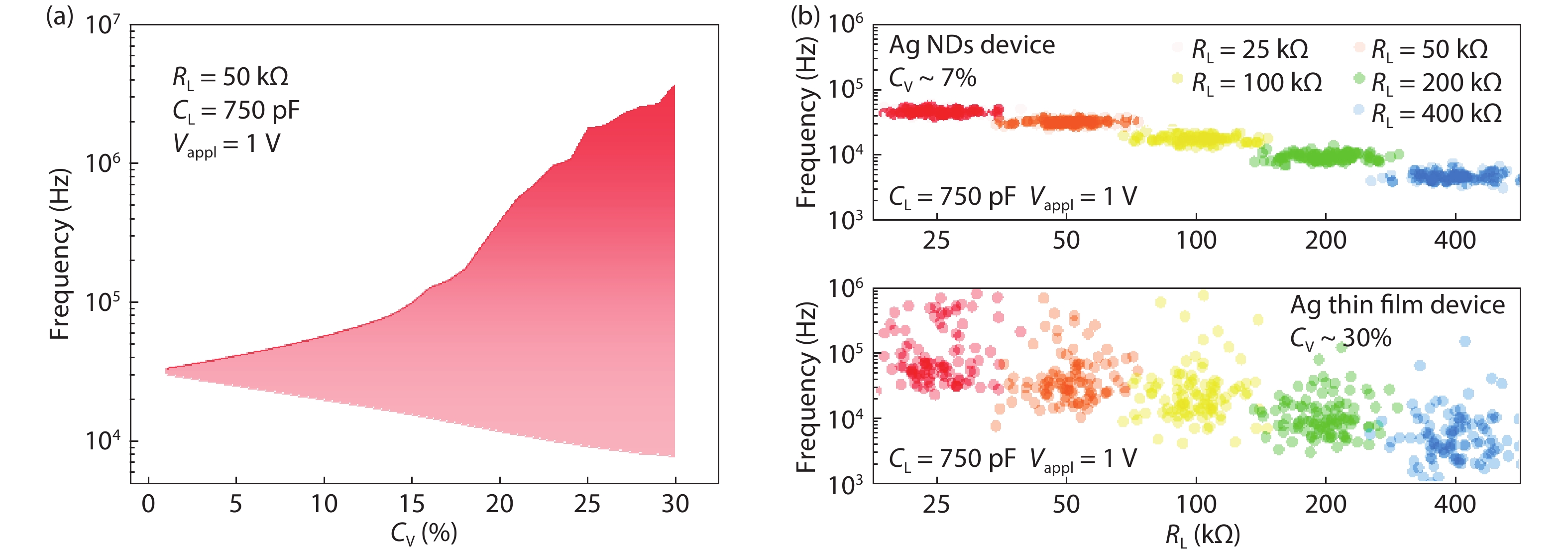| Citation: |
Yujia Li, Jianshi Tang, Bin Gao, Xinyi Li, Yue Xi, Wanrong Zhang, He Qian, Huaqiang Wu. Oscillation neuron based on a low-variability threshold switching device for high-performance neuromorphic computing[J]. Journal of Semiconductors, 2021, 42(6): 064101. doi: 10.1088/1674-4926/42/6/064101
****
Y J Li, J S Tang, B Gao, X Y Li, Y Xi, W R Zhang, H Qian, H Q Wu, Oscillation neuron based on a low-variability threshold switching device for high-performance neuromorphic computing[J]. J. Semicond., 2021, 42(6): 064101. doi: 10.1088/1674-4926/42/6/064101.
|
Oscillation neuron based on a low-variability threshold switching device for high-performance neuromorphic computing
DOI: 10.1088/1674-4926/42/6/064101
More Information
-
Abstract
Low-power and low-variability artificial neuronal devices are highly desired for high-performance neuromorphic computing. In this paper, an oscillation neuron based on a low-variability Ag nanodots (NDs) threshold switching (TS) device with low operation voltage, large on/off ratio and high uniformity is presented. Measurement results indicate that this neuron demonstrates self-oscillation behavior under applied voltages as low as 1 V. The oscillation frequency increases with the applied voltage pulse amplitude and decreases with the load resistance. It can then be used to evaluate the resistive random-access memory (RRAM) synaptic weights accurately when the oscillation neuron is connected to the output of the RRAM crossbar array for neuromorphic computing. Meanwhile, simulation results show that a large RRAM crossbar array (> 128 × 128) can be supported by our oscillation neuron owing to the high on/off ratio (> 108) of Ag NDs TS device. Moreover, the high uniformity of the Ag NDs TS device helps improve the distribution of the output frequency and suppress the degradation of neural network recognition accuracy (< 1%). Therefore, the developed oscillation neuron based on the Ag NDs TS device shows great potential for future neuromorphic computing applications. -
References
[1] Indiveri G, Linares-Barranco B, Legenstein R, et al. Integration of nanoscale memristor synapses in neuromorphic computing architectures. Nanotechnology, 2013, 24, 384010 doi: 10.1088/0957-4484/24/38/384010[2] Ambrogio S, Balatti S, Milo V, et al. Neuromorphic learning and recognition with one-transistor-one-resistor synapses and bistable metal oxide RRAM. IEEE Trans Electron Devices, 2016, 63, 1508 doi: 10.1109/TED.2016.2526647[3] Burr G W, Shelby R M, Sebastian A, et al. Neuromorphic computing using non-volatile memory. Adv Phys X, 2017, 2, 89 doi: 10.1080/23746149.2016.1259585[4] Zidan M A, Strachan J P, Lu W D. The future of electronics based on memristive systems. Nat Electron, 2018, 1, 22 doi: 10.1038/s41928-017-0006-8[5] Merrikh B F, Prezioso M, Chakrabarti B, et al. Implementation of multilayer perceptron network with highly uniform passive memristive crossbar circuits. Nat Commun, 2017, 9, 2331 doi: 10.1038/s41467-018-04482-4[6] Yao P, Wu H Q, Gao B, et al. Fully hardware-implemented memristor convolutional neural network. Nature, 2020, 577, 641 doi: 10.1038/s41586-020-1942-4[7] Choi S, Yang J, Wang G. Emerging memristive artificial synapses and neurons for energy-efficient neuromorphic computing. Adv Mater, 2020, 32, 2004659 doi: 10.1002/adma.202004659[8] Zhu J D, Zhang T, Yang Y C, et al. A comprehensive review on emerging artificial neuromorphic devices. Appl Phys Rev, 2020, 7, 011312 doi: 10.1063/1.5118217[9] Kadetotad D, Xu Z H, Mohanty A, et al. Parallel architecture with resistive crosspoint array for dictionary learning acceleration. IEEE J Emerg Sel Top Circuits Syst, 2015, 5, 194 doi: 10.1109/JETCAS.2015.2426495[10] Hua Q L, Wu H Q, Gao B, et al. Low-voltage oscillatory neurons for memristor-based neuromorphic systems. Glob Challenges, 2019, 3, 1900015 doi: 10.1002/gch2.201900015[11] Dang B J, Liu K Q, Zhu J D, et al. Stochastic neuron based on IGZO Schottky diodes for neuromorphic computing. APL Mater, 2019, 7, 071114 doi: 10.1063/1.5109090[12] Li S, Liu X J, Nandi S K, et al. High-endurance MHz electrical self-oscillation in Ti/NbOx bilayer structures. Appl Phys Lett, 2015, 106, 212902 doi: 10.1063/1.4921745[13] Gao L G, Chen P Y, Yu S M. NbOx based oscillation neuron for neuromorphic computing. Appl Phys Lett, 2017, 111, 103503 doi: 10.1063/1.4991917[14] Duan Q X, Jing Z K, Yang K, et al. Oscillation neuron based on threshold switching characteristics of niobium oxide films. 2019 IEEE International Workshop on Future Computing, 2019, 1[15] Woo J, Wang P N, Yu S M. Integrated crossbar array with resistive synapses and oscillation neurons. IEEE Electron Device Lett, 2019, 40, 1313 doi: 10.1109/LED.2019.2921656[16] Wang P N, Khan A I, Yu S M. Cryogenic behavior of NbO2 based threshold switching devices as oscillation neurons. Appl Phys Lett, 2020, 116, 162108 doi: 10.1063/5.0006467[17] Luo Q, Xu X, Lv H, et al. Cu BEOL compatible selector with high selectivity (> 107), extremely low off-current (pA) and high endurance (> 1010). 2015 IEEE International Electron Devices Meeting (IEDM), 2015, 10.4.1[18] Yoo J, Woo J, Song J, et al. Threshold switching behavior of Ag-Si based selector device and hydrogen doping effect on its characteristics. AIP Adv, 2015, 5, 127221 doi: 10.1063/1.4938548[19] Du G, Wang C, Li H X, et al. Bidirectional threshold switching characteristics in Ag/ZrO2/Pt electrochemical metallization cells. AIP Adv, 2016, 6, 085316 doi: 10.1063/1.4961709[20] Wang Z R, Rao M Y, Midya R, et al. Threshold switching: Threshold switching of Ag or Cu in dielectrics: Materials, mechanism, and applications. Adv Funct Mater, 2018, 28, 1870036 doi: 10.1002/adfm.201870036[21] Yoo J, Park J, Song J, et al. Field-induced nucleation in threshold switching characteristics of electrochemical metallization devices. Appl Phys Lett, 2017, 111, 063109 doi: 10.1063/1.4985165[22] Wang W, Wang M, Ambrosi E, et al. Surface diffusion-limited lifetime of silver and copper nanofilaments in resistive switching devices. Nat Commun, 2019, 10, 81 doi: https://doi.org/10.1038/s41467-018-07979-0[23] Hua Q L, Wu H Q, Gao B, et al. Threshold switching selectors: A threshold switching selector based on highly ordered Ag nanodots for X-point memory applications. Adv Sci, 2019, 6, 1970058 doi: 10.1002/advs.201970058[24] Li Y J, Tang J S, Gao B, et al. High-uniformity threshold switching HfO2 -based selectors with patterned Ag nanodots. Adv Sci, 2020, 7, 2002251 doi: 10.1002/advs.202002251[25] Xi Y, Gao B, Tang J S, et al. In-memory learning with analog resistive switching memory: A review and perspective. Proc IEEE, 2021, 109, 14 doi: 10.1109/JPROC.2020.3004543 -
Proportional views






 DownLoad:
DownLoad:



















